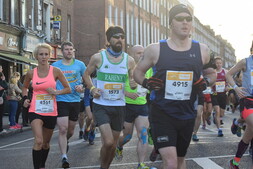|
Running might be one of the most natural things we do as humans. As the title of Christopher McDougall’s book, of the famous Springsteen song implies, “baby, we were born to run!” Chance are, if you’re reading this, your either already runner, or looking for the best way to start. Regardless of your background, or experience, the best place you can start is with your form! Why start with from, and not run/walk intervals, what shoes to buy, or how many miles to start with? Well, ask yourself this. If you’ve run before, have you ever had to miss a workout due to pain? Have you ever had to slow down, or drop out of a race because your legs couldn’t handle any more? Maybe it was a tweaky knee, shin splits, IT band syndrome, or planter fasciitis? If you’re like 80% of the running community, chances are you’ve been sidelined or dropped out of a race at least once each season with an injury.
But, what if the majority of injuries were preventable? What if you weren’t missing workouts due to pain? Could fewer missed workouts mean better endurance, faster times, greater VO2Max? Could it mean greater confidence in moving from a sprint tri to an Olympic, or even Ironman? Most importantly, could it mean NOT waking up at 50 or 60 years old saying “I used to love running, but it was so hard on the body, that I had to quit.” The good news is that with just a little bit of focus, most runners can self-identify issues with their form and begin to correct it. Imporving form won’t happen overnight, , but making a few small investments now can really pay off and can keep you running for decades to come. Here are a few of my favorite tips! Top Five Running Tips to Avoid Injury
Let’s look at these in a little more detail. Listen to your body, and pay attention to pain Use the concept of “Body Sensing,” or more simply put, paying attention to what you’re feeling, and making adjustments as appropriate. We often tune out what our bodies are telling us. For instance, how many times have you popped Advil before heading out the door for a run because your knee hurt, but you “had to get 5 more miles in?” Listen to the aches and pains your body throws at you. Chat with a running or triathlon coach let them know what you’re feeling and where. Chances are a few slight changes to your posture could make a world of difference. Be mindful of your posture and work to perfect it Posture is probably the most important aspect of not only running, but living a healthy life in general. By keeping good posture we keep our spines healthy, allow our body weight to be supported by our skeletal system (vs. over using our muscles to hold it up), and set the foundations for good movement. Try to imagine that you can draw a straight line from your ear, to your shoulder, down through the hip, to the ankle. If you have trouble lining up these “dots,” imagine you're being lifted up with a string from the crown of your head. This simple visualization will help you lengthen your neck, engage your core, and bring your body into alignment! Strive for a mid-foot or forefoot landing First things first, if you’re a heel striker (as 80% of runners tend to be), DO NOT force a transition overnight. You need to take your time in order to avoid injury. That said, the impact associated with forefoot running (landing on the ball of the foot) and mid-foot running (landing on the ball of the foot and the heel at the same time), is far less than the force generated by landing on the heel. Think about how your body feels when you land this way. You’ll notice you’re a lot more “springy” and lighter on your feet. If you’re having trouble feeling this, take your shoes off and do a little barefoot running. Almost everyone transitions to a forefoot strike when running barefoot. Shorten your stride The key to a great stride, is to let it get long behind you. Most runners strides are way too long in front of their bodies. This usually means that their knee ends up fully extended just before the foot crashes into the ground, with the heel leading the way. This sends a ton of force up through the body. Instead, we want to focus on keeping the stride contained up front, so that the leg can open up and swing behind us. Imagine staying in good posture, allowing your shoulders and upper body to fall forward, while your legs sweep back! Let your foot land below your knee Another great way to avoid over striding, and promote a proper foot strike, is to make sure your foot is landing below your knee. If you let the foot land ahead of the knee, it will act like a brake for your whole body. The pounding that occurs with that braking motion can lead to issues like plantar fasciitis, shin splints, knee or hip pain, and lower back issues. If you let the foot fall below the knee, you can reduce this impact, allow the road to sweep your foot back, and fall forward into gravity minimizing your overall effort! This might all seem overwhelming, but when you focus on one or two small aspects at a time, you’ll start to see changes in your form. Don’t expect a transformation to happen overnight. Look
0 Comments
Leave a Reply. |
Click to set custom HTML
AuthorKen Presutti is a certified ChiRunning instructor, ACE Personal trainer, Spinning instructor, and coach. This blog is a mix of new articles and posts from his original blog, Overkill is Underrated. Archives
November 2022
Categories
All
|


 RSS Feed
RSS Feed
